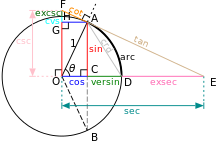弦函數的函數圖形 弦函數 (chord function ),又稱全弦 [ 1] 三角函數 之一[ 2] crd θ {\displaystyle \operatorname {crd} \theta } [ 3] 古希臘 數學家喜帕恰斯 所定義[ 4] 三角學 的早期發展中被廣泛使用,主要用於解決天文學 計算的問題[ 5] [ 6] 函數值 為該角在單位圓 上的弦長[ 7] 圓心角 θ {\displaystyle \theta } 半徑 的比值[ 8] 單位圓 上角的終邊端點到始邊端點的距離 。 弦函數與正弦函數 不太一樣,但關係十分密切[ 8] π 弧度 (180度 )之間的全弦(crd)與正弦 (sin)的關係為crd θ = 2 sin θ / 2 [ 9]
假設角θ π crd θ {\displaystyle \operatorname {crd} \theta } 圓心角 ∠AOB 等腰三角形 ΔOAB 底邊 長 A B ¯ {\displaystyle {\overline {AB}}} [ 2] O 圓心 ,即圓心角 的頂點 。 弦函數的幾何定義如右圖所示。 角的弦函數值是單位圓上由該圓心角分隔的兩點之間的弦的長度。 角度θ 0 < θ ≤ π 0 < θ ≤ 180 (1,0) (cos θ , sin θ ) [ 10]
crd θ = ( 1 − cos θ ) 2 + sin 2 θ = 2 − 2 cos θ = 2 sin ( θ 2 ) . {\displaystyle \operatorname {crd} \ \theta ={\sqrt {(1-\cos \theta )^{2}+\sin ^{2}\theta }}={\sqrt {2-2\cos \theta }}=2\sin \left({\frac {\theta }{2}}\right).} [ 11] [ 註 1] 弦函數(藍色)、正弦函數 (黃色)與正矢函數 (綠色)的函數圖形 crd函數(灰色)在單位圓上的位置 原始的弦函數只定義在0至π 同界角 的性質進行擴展定義。圖為使用公式 y = crd x = 2 − 2 cos x {\displaystyle y=\operatorname {crd} \ x={\sqrt {2-2\cos x}}} 也就是說,弦長度可以透過下列等式來計算:[ 7]
弦長 = r crd θ = 2 r sin θ 2 {\displaystyle r\operatorname {crd} \theta =2r\sin {\frac {\theta }{2}}} 其中,r θ
弦函數與正弦函數 相關聯。 在下表中,弦函數可以滿足許多類似於眾所周知的現代函數的恆等式:
明成 基於正弦函數 基於弦函數 勾股定理 sin 2 θ + cos 2 θ = 1 {\displaystyle \sin ^{2}\theta +\cos ^{2}\theta =1\,} crd 2 θ + crd 2 ( π − θ ) = 4 {\displaystyle \operatorname {crd} ^{2}\theta +\operatorname {crd} ^{2}(\pi -\theta )=4\,} 半角公式 sin θ 2 = ± 1 − cos θ 2 {\displaystyle \sin {\frac {\theta }{2}}=\pm {\sqrt {\frac {1-\cos \theta }{2}}}\,} crd θ 2 = 2 − crd ( π − θ ) {\displaystyle \operatorname {crd} \ {\frac {\theta }{2}}={\sqrt {2-\operatorname {crd} (\pi -\theta )}}\,} 边心距 (a ) c = 2 r 2 − a 2 {\displaystyle c=2{\sqrt {r^{2}-a^{2}}}} c = D 2 − 4 a 2 {\displaystyle c={\sqrt {D^{2}-4a^{2}}}} 角 (θ ) c = 2 r sin ( θ 2 ) {\displaystyle c=2r\sin \left({\frac {\theta }{2}}\right)} c = D 2 crd θ {\displaystyle c={\frac {D}{2}}\operatorname {crd} \ \theta } 其中,c r D θ
弦函數也可以表達成如下指數定義:
crd x = 2 − e i x − e − i x {\displaystyle \operatorname {crd} \ x={\sqrt {2-e^{ix}-e^{-ix}}}} 最早已知的弦函數表由喜帕恰斯 編制,其列出了每7+ 1 / 2 度的弦函數值 。 在公元二世紀,亞歷山大的托勒密 在他的天文學書《天文學大成 》中編制了弦函數的函數表——托勒密全弦表 ,其給出了從1 / 2 1 / 2 [ 10] 托勒密全弦表 所列出的值是弦函數的60倍,例如 crd 60 ∘ = 1 {\displaystyle \operatorname {crd} 60^{\circ }=1} [ 12]
弦函數與現代常用的正弦函數之關係可以看做是正弦函數代入半角公式 的結果。
crd θ = 2 sin ( θ 2 ) {\displaystyle \operatorname {crd} \ \theta =2\sin \left({\frac {\theta }{2}}\right)} [ 13] [ 註 1] 上述等式只成立於0 < θ ≤ π 0 < θ ≤ 180
正如現代三角學是建立在正弦函數的基礎上一樣,古代三角學也是建立在和弦函數的基礎上。 據說喜帕恰斯寫了一本十二卷的關於弦函數的著作,雖然現在全部都失傳了,但想必人們對弦函數有一定的了解。[ 15]
托勒密所建立的托勒密全弦表 是紀錄特定圓心角θ ° chord ( θ ) {\displaystyle \operatorname {chord} (\theta )} [ 16] [ 17]
chord ( θ ) = 120 sin ( θ ∘ 2 ) = 60 ⋅ ( 2 sin ( π θ ∘ 360 radians ) ) . {\displaystyle {\begin{aligned}&\operatorname {chord} (\theta )=120\sin \left({\frac {\theta ^{\circ }}{2}}\right)\\={}&60\cdot \left(2\,\sin \left({\frac {\pi \theta ^{\circ }}{360}}{\text{ radians}}\right)\right).\end{aligned}}} d d θ crd ( θ ) = cos ( θ 2 ) {\displaystyle {\frac {\mathrm {d} }{\mathrm {d} \theta }}\operatorname {crd} (\theta )=\cos \left({\frac {\theta }{2}}\right)} 0 < θ ≤ π [ 註 2] d d θ crd ( θ ) = sin ( θ ) 2 − 2 cos ( θ ) = 2 sin ( θ ) ( 1 − cos ( θ ) ) + 2 sin ( θ ) cos ( θ ) 2 sin 2 ( θ ) + ( 1 − cos ( θ ) ) 2 {\displaystyle {\frac {\mathrm {d} }{\mathrm {d} \theta }}\operatorname {crd} (\theta )={\frac {\sin(\theta )}{\sqrt {2-2\cos(\theta )}}}={\frac {2\sin(\theta )(1-\cos(\theta ))+2\sin(\theta )\cos(\theta )}{2{\sqrt {\sin ^{2}(\theta )+(1-\cos(\theta ))^{2}}}}}} ∫ crd ( θ ) d θ = − 4 cos ( θ 2 ) + C {\displaystyle \int \operatorname {crd} (\theta )\,\mathrm {d} \theta =-4\cos \left({\frac {\theta }{2}}\right)+C} 0 < θ ≤ π [ 註 2] ∫ crd ( θ ) d θ = − 2 2 − 2 cos ( θ ) cot ( θ 2 ) + C {\displaystyle \int \operatorname {crd} (\theta )\,\mathrm {d} \theta =-2{\sqrt {2-2\cos(\theta )}}\cot \left({\frac {\theta }{2}}\right)+C} crd ( α ± β ) = 1 2 crd ( α ) 4 − crd 2 ( β ) ± 1 2 crd ( β ) 4 − crd 2 ( α ) {\displaystyle \operatorname {crd} \left(\alpha \pm \beta \right)={\frac {1}{2}}\operatorname {crd} \left(\alpha \right){\sqrt {4-\operatorname {crd} ^{2}\left(\beta \right)}}\pm {\frac {1}{2}}\operatorname {crd} \left(\beta \right){\sqrt {4-\operatorname {crd} ^{2}\left(\alpha \right)}}} [ 13] crd ( θ 2 ) = 2 − crd ( π − θ ) {\displaystyle \operatorname {crd} \left({\frac {\theta }{2}}\right)={\sqrt {2-\operatorname {crd} (\pi -\theta )}}} crd ( 2 θ ) = crd ( θ ) 4 − crd 2 ( θ ) = 2 sin θ {\displaystyle \operatorname {crd} \left(2\theta \right)=\operatorname {crd} \left(\theta \right){\sqrt {4-\operatorname {crd} ^{2}(\theta )}}=2\sin \theta } [ 18] crd ( 3 θ ) = 3 crd ( θ ) − crd 3 ( θ ) {\displaystyle \operatorname {crd} \left(3\theta \right)=3\operatorname {crd} \left(\theta \right)-\operatorname {crd} ^{3}\left(\theta \right)} [ 13] 正弦定理 也可以寫成基於弦函數的形式:[ 19]
crd 2 A a = crd 2 B b = crd 2 C c {\displaystyle {\frac {\operatorname {crd} \ 2A}{a}}={\frac {\operatorname {crd} \ 2B}{b}}={\frac {\operatorname {crd} \ 2C}{c}}} 其中,a、b和c為三角形的三條邊;而A、B和C則為對應邊的對角。
弦函數可以透過正弦 、餘弦 和正矢 等函數來構造:[ 20]
crd θ = 2 sin ( θ 2 ) {\displaystyle \operatorname {crd} \ \theta =2\sin \left({\frac {\theta }{2}}\right)} [ 20] 0 < θ ≤ π 0 < θ ≤ 180° crd θ = 2 − 2 cos θ {\displaystyle \operatorname {crd} \ \theta ={\sqrt {2-2\cos \theta }}} [ 20] crd θ = 2 versin θ {\displaystyle \operatorname {crd} \ \theta ={\sqrt {2\operatorname {versin} \ \theta }}} [ 20] crd ( 0 ) = 0 {\displaystyle \operatorname {crd} \left(0\right)=0} crd ( π 15 ) = crd ( 12 ∘ ) = 30 − 6 5 − 6 + 2 5 4 {\displaystyle \operatorname {crd} \left({\frac {\pi }{15}}\right)=\operatorname {crd} \left(12^{\circ }\right)={\frac {{\sqrt {30-6{\sqrt {5}}}}-{\sqrt {6+2{\sqrt {5}}}}}{4}}} [ 13] crd ( π 5 ) = crd ( 36 ∘ ) = 5 − 1 2 {\displaystyle \operatorname {crd} \left({\frac {\pi }{5}}\right)=\operatorname {crd} \left(36^{\circ }\right)={\frac {{\sqrt {5}}-1}{2}}} [ 13] crd ( π 3 ) = crd ( 60 ∘ ) = 1 {\displaystyle \operatorname {crd} \left({\frac {\pi }{3}}\right)=\operatorname {crd} \left(60^{\circ }\right)=1} [ 13] crd ( 2 π 5 ) = crd ( 72 ∘ ) = 10 − 2 5 2 {\displaystyle \operatorname {crd} \left({\frac {2\pi }{5}}\right)=\operatorname {crd} \left(72^{\circ }\right)={\frac {10-2{\sqrt {5}}}{2}}} [ 13] crd ( π 2 ) = crd ( 90 ∘ ) = 2 {\displaystyle \operatorname {crd} \left({\frac {\pi }{2}}\right)=\operatorname {crd} \left(90^{\circ }\right)={\sqrt {2}}} [ 13] crd ( 3 π 5 ) = crd ( 108 ∘ ) = 6 + 2 5 2 {\displaystyle \operatorname {crd} \left({\frac {3\pi }{5}}\right)=\operatorname {crd} \left(108^{\circ }\right)={\frac {6+2{\sqrt {5}}}{2}}} [ 13] crd ( 2 π 3 ) = crd ( 120 ∘ ) = 3 {\displaystyle \operatorname {crd} \left({\frac {2\pi }{3}}\right)=\operatorname {crd} \left(120^{\circ }\right)={\sqrt {3}}} [ 13] crd ( 4 π 5 ) = crd ( 144 ∘ ) = 10 + 2 5 2 {\displaystyle \operatorname {crd} \left({\frac {4\pi }{5}}\right)=\operatorname {crd} \left(144^{\circ }\right)={\frac {10+2{\sqrt {5}}}{2}}} [ 13] crd ( π ) = crd ( 180 ∘ ) = 2 {\displaystyle \operatorname {crd} \left(\pi \right)=\operatorname {crd} \left(180^{\circ }\right)=2} 弦函數的反函數 弦函數的反函數可以定義如下:
crd − 1 y = 2 arcsin y 2 {\displaystyle \operatorname {crd} ^{-1}\ y=2\arcsin {\frac {y}{2}}} 在這定義下只有0 ≤ y ≤ 2
或者用 crd θ = 2 − 2 cos θ {\displaystyle \operatorname {crd} \ \theta ={\sqrt {2-2\cos \theta }}}
crd − 1 y = arccos 2 − y 2 2 {\displaystyle \operatorname {crd} ^{-1}\ y=\arccos {\frac {2-y^{2}}{2}}} 反弦函數有時會簡稱為acrd[ 6]
因此已知弦長 可以回推圓心角的角度: [ 21]
θ = 2 arcsin c 2 r {\displaystyle \theta =2\arcsin {\frac {c}{2r}}} 其中,其中c是弦長、r是圓的半徑。
正弦(sin)、餘弦(cos)、全弦(crd)、正矢(versin)、和半正矢(haversin)函數的函數圖形 弦函數的值域 範圍在0到2之間,類似的函數還有正矢函數 (versin),值域範圍也在0到2之間,但函數圖形 略有差異。 弦函數在範圍0到π 正弦函數 0到π / 2 正弦 、正切 、正割 、正矢 )同樣是從零開始遞增的函數。
弧長(arc θ crd θ sin θ 與弦函數(crd θ arc θ θ 圓弧 之弧長 [ 5] 這個概念有時稱為正弧 [ 22] ,對應於割圓八線 中正角的弧 arc θ crd θ [ 5] arc θ
arc θ crd θ 在單位圓上,arc θ 2π θ 2π 最小正同界角 的弧度值。
割圓八線 。正角對應的弧為正弧(乙丙)、餘角對應的弧為餘弧(乙庚)相同的概念在割圓八線 中也存在。 arc θ 正弧 」,即正角(θ arc θ 也存在對應的餘弧(coarc θ 直角 與正角之差所對應的弧[ 23] coarc θ = arc(π / 2 θ ) [ 22] [ 24] [ 24]
^ 1.0 1.1 1.2 事實上,將crd函數定義為 crd θ = 2 sin ( θ 2 ) {\displaystyle \operatorname {crd} \ \theta =2\sin \left({\frac {\theta }{2}}\right)} 2 sin ( θ 2 ) {\displaystyle 2\sin \left({\frac {\theta }{2}}\right)} 0 < θ ≤ π 0 < θ ≤ 180 ^ 2.0 2.1 此等式是使用 crd θ = 2 sin ( θ 2 ) {\displaystyle \operatorname {crd} \ \theta =2\sin \left({\frac {\theta }{2}}\right)} [ 註 1] 0 < θ ≤ π 0 < θ ≤ 180 ^ 蔡聰明. 數學拾貝. 三民書局 . 2020-01-17: 225. ISBN 9789571467634 ^ 2.0 2.1 The Chord Function (PDF) . math.ucr.edu. [2023-10-26 ] . (原始内容存档 (PDF) 于2023-01-19). ^ Hodgkin, L. A History of Mathematics: From Mesopotamia to Modernity . OUP Oxford. 2013: 130. ISBN 9780191664366 ^ Hipparchus of Rhodes . mathshistory.st-andrews.ac.uk. [2023-10-26 ] . (原始内容存档 于2007-10-23). ^ 5.0 5.1 5.2 Folkerts, Menso and Launert, Dieter and Thom, Andreas. Jost Bürgi's method for calculating sines. Historia mathematica (Elsevier). 2016, 43 (2): 133–147. ^ 6.0 6.1 Alan Lang@std/trig . alan-lang.org. [2023-10-27 ] . (原始内容存档 于2023-03-20). ^ 7.0 7.1 Sozio, Gerardo. Trigonometry: Chords, Arcs and Angles (PDF) . Parabola. 2005,. Volume 41 (Issue 1) [2023-10-27 ] . (原始内容存档 (PDF) 于2023-02-13). ^ 8.0 8.1 吳俊輝; 姚珩; 徐光台 等著. 星空協奏曲 . 知識漫遊. 國立臺灣大學出版中心出版. 2013: 59 [2023-10-27 ] . ISBN 9789860380224存档 于2023-10-28). ^ Eng, M and Schwarz, René. Trigonometric Functions (PDF) . Image. 2017, 3 (2): 4 [2023-10-31 ] . (原始内容存档 (PDF) 于2023-10-31). ^ 10.0 10.1 Maor, Eli, Trigonometric Delights, Princeton University Press: 25–27, 1998, ISBN 978-0-691-15820-4 ^ Weisstein, Eric W. (编). Circular Segment . at MathWorld Wolfram Research, Inc. (英语) . ^ Chapter 5. Introduction of Western Mathematics : Trigonometric Tables . www.ndl.go.jp. [2023-10-26 ] . (原始内容存档 于2022-10-05). ^ 13.00 13.01 13.02 13.03 13.04 13.05 13.06 13.07 13.08 13.09 13.10 蔡聰明. 星空燦爛的數學(I)——托勒密如何編製弦表? (PDF) . 數學傳播. 1999年6月, 23卷 (2期): 57–67 [2023-10-27 ] . (原始内容存档 (PDF) 于2021-05-06). ^ Thurston, Hugh, Early Astronomy, Springer, 1996, ISBN 978-0-387-94822-5 ^ Thurston[ 14] pp. 235–236 ^ Rodica Nan. PI – Not Just an Ordinary Number . John Carroll University. 2020 [2023-10-28 ] . (原始内容存档 于2023-04-17). ^ Chapter 5. Trigonometry (PDF) . faculty.etsu.edu: 5. [2023-10-28 ] . (原始内容存档 (PDF) 于2023-05-28). ^ Ganikhodjaev, Nasir and Husain, Ahmad Hamidi. Al-Kāshī, the first scientist who introduced dynamical system. AIP Conference Proceedings (AIP Publishing). 2018, 1974 (1). ^ Duke, Dennis W. Hipparchus' eclipse trios and early trigonometry (PDF) . Centaurus-Oxford (Copenhagen: Munksgaard, 1950). 2005, 47 (2): 163–177 [2023-10-31 ] . (原始内容存档 (PDF) 于2023-10-31). ^ 20.0 20.1 20.2 20.3 Trig Functions and Naming Conventions . resources.wolframcloud.com. [2023-10-31 ] . (原始内容存档 于2023-10-31). ^ Simpson, David G. AUXTRIG (FORTRAN-90 source code). Greenbelt, Maryland, USA: NASA Goddard Space Flight Center. 2001-11-08 [2015-10-26 ] . (原始内容存档 于2008-06-16). ^ 22.0 22.1 梅文鼎. 測算名義. 《平三角舉要》. ^ 方愷. 平三角附測量 (PDF) . 代數通藝錄 (成文堂刊本). 1890, 卷十三 [2023-11-06 ] . (原始内容存档 (PDF) 于2023-03-26). ^ 24.0 24.1 彭良禎. 《平三角舉要》與《方圓羃積》初探 . HPM通訊 (國立臺灣師範大學數學系). [2023-11-05 ] . (原始内容存档 于2013-08-04).











 French
French Deutsch
Deutsch













































